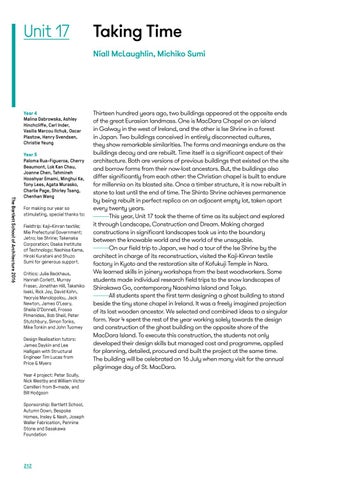Unit 17
Taking Time Níall McLaughlin, Michiko Sumi
Year 4 Malina Dabrowska, Ashley Hinchcliffe, Carl Inder, Vasilis Marcou Ilchuk, Oscar Plastow, Henry Svendsen, Christie Yeung
The Bartlett School of Architecture 2016
Year 5 Paloma Rua-Figueroa, Cherry Beaumont, Lok Kan Chau, Joanne Chen, Tahmineh Hooshyar Emami, Minghui Ke, Tony Lees, Agata Murasko, Charlie Page, Shirley Tsang, Chenhan Wang For making our year so stimulating, special thanks to: Fieldtrip: Kaji-Kinran textile; Mie Prefectural Government; Jetro; Ise Shrine; Takenaka Corporation; Osaka Institute of Technology; Naohisa Kama, Hiroki Kuratani and Shuzo Sumi for generous support. Critics: Julia Backhaus, Hannah Corlett, Murray Fraser, Jonathan Hill, Takehiko Iseki, Rick Joy, David Kohn, Yeoryia Manolopolou, Jack Newton, James O’Leary, Sheila O’Donnell, Frosso Pimenides, Bob Sheil, Peter Stutchbury, Simon Tonks, Mike Tonkin and John Tuomey Design Realisation tutors: James Daykin and Lee Halligain with Structural Engineer Tim Lucas from Price & Myers Year 4 project: Peter Scully, Nick Westby and William Victor Camilleri from B-made, and Bill Hodgson Sponsorship: Bartlett School, Autumn Down, Bespoke Homes, Insley & Nash, Joseph Waller Fabrication, Pennine Stone and Sasakawa Foundation
212
Thirteen hundred years ago, two buildings appeared at the opposite ends of the great Eurasian landmass. One is MacDara Chapel on an island in Galway in the west of Ireland, and the other is Ise Shrine in a forest in Japan. Two buildings conceived in entirely disconnected cultures, they show remarkable similarities. The forms and meanings endure as the buildings decay and are rebuilt. Time itself is a significant aspect of their architecture. Both are versions of previous buildings that existed on the site and borrow forms from their now-lost ancestors. But, the buildings also differ significantly from each other: the Christian chapel is built to endure for millennia on its blasted site. Once a timber structure, it is now rebuilt in stone to last until the end of time. The Shinto Shrine achieves permanence by being rebuilt in perfect replica on an adjacent empty lot, taken apart every twenty years. This year, Unit 17 took the theme of time as its subject and explored it through Landscape, Construction and Dream. Making charged constructions in significant landscapes took us into the boundary between the knowable world and the world of the unsayable. On our field trip to Japan, we had a tour of the Ise Shrine by the architect in charge of its reconstruction, visited the Kaji-Kinran textile factory in Kyoto and the restoration site of Kofukuji Temple in Nara. We learned skills in joinery workshops from the best woodworkers. Some students made individual research field trips to the snow landscapes of Shirakawa Go, contemporary Naoshima Island and Tokyo. All students spent the first term designing a ghost building to stand beside the tiny stone chapel in Ireland. It was a freely imagined projection of its lost wooden ancestor. We selected and combined ideas to a singular form. Year 4 spent the rest of the year working solely towards the design and construction of the ghost building on the opposite shore of the MacDara Island. To execute this construction, the students not only developed their design skills but managed cost and programme, applied for planning, detailed, procured and built the project at the same time. The building will be celebrated on 16 July when many visit for the annual pilgrimage day of St. MacDara.
